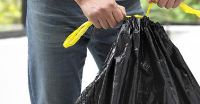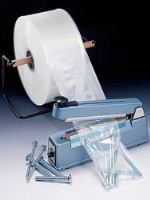What's New
We Do Packaging relocate to new premises
Will it Break? - Bubble Wrap Appreciation Day special
Bubble Wrap® Appreciation Day is celebrated every year on the last Monday in January, and this is the first Will it Break? video created in honour of this popular awareness day. With the new 'Extreme Series' launched to show the difference in packed and unpacked product impacts.
In order to test Sealed Air's trademark Aircap®, a member of the Bubble Wrap® brand family, invented in 1957 by Alfred Fielding and Marc Chavannes, Professor Packaging aims to conquer the mile-long wire in North Wales to see if his precious egg can survive.
Paste the link to watch the video
http://www.youtube.com/watch?v=W4Fzwq03hZY

Black Sacks and Bin Bags
Waste bags - Black Sacks - Rubbish bags - Bin Bags
'Waste bags and Sacks' are flexible material used for lining
litter or waste containers or bins. This serves to keep the container sanitary
by avoiding container contact with the rubbish. After the bag in the container
is filled with litter, the bag can be conveniently pulled out by its edges,
closed, and tied.
It is widely used for collection, storage, disposal and
handling of different waste stream such as clinical, recycling, domestic,
hospital, kitchen waste etc. Most bags nowadays are made out of plastic. 'Waste
bags' also known as garbage bags, rubbish bags, refuse sacks, bin liner &
can liner etc.
History of Waste (Garbage) bags
The familiar black/green plastic garbage bag (made from
polyethylene) was invented by Harry Wasylyk in 1950.Harry Wasylyk was a
Canadian inventor from Winnipeg, Manitoba, who together with Larry Hansen of
Lindsay, Ontario, invented the disposable green polyethylene garbage bag.
Garbage bags were first intended for commercial use rather
than home use - the bags were first sold to the Winnipeg General Hospital.
However, Hansen worked for the Union Carbide Company in Lindsay, who bought the
invention from Wasylyk and Hansen. Union Carbide manufactured the first green
garbage bags under the name Glad Garbage bags for home use in the late 1960s.

Poly-tubing & Sheeting
'Poly-tubing' is a flexible, continuous roll of polythene
sleeving open at one end and rolled up at other; either on plastic or cardboard
core. Economical & easiest way to package or enclose objects of same width
but various lengths. Ideal for packaging odd shaped or long items. Simply
insert your product into the tubing, cut to required length and heat seal,
staple or tape one or both ends. It is also known as 'Layflat tubing'. Usually
rolled up to 12" in diameter on a 3" wide core.
'Sheeting' - When Polytubing is slit it is known as
'Sheeting'. There are variety of Sheeting available on the market today,
depending the way they cut and wounded. Examples of these are Single wound
sheeting, Double wound sheeting, Centrefold sheeting, J-fold sheeting &
Centerslit sheeting. Sheeting provides economical protection from dirt, dust
and moisture.
How it is made?
Most Polytubing & Sheeting are made from polyethylene;
mostly from Low density polythene, which is made from crude oil and natural
gas, non-renewable resources. The most common way to produce 'Polytubing' is by
blown film extrusion, also called the 'tubular film process'.
In Blown film production process - polythene melt is extruded
through an annular slit die, usually vertically, to form a thin walled tube.
Air is introduced via a hole in the centre of the die to blow up the tube like
a balloon. into the tube causing it to expand and form a bubble. Mounted on top
of the die, a high-speed air ring blows onto the hot film to cool it. The tube
of film then continues upwards, continually cooling, until it passes through
nip rolls where the tube is flattened to create what is known as a ' lay-flat'
tube of film. This lay-flat or collapsed tube is then taken back down the
extrusion ' tower' via more rollers. The lay-flat film is then either kept as
such or the edges of the lay-flat are slit off to produce two flat film
sheeting and wound up onto reels. If kept as lay-flat is known as 'layflat
tubing' or 'Polytubing'













